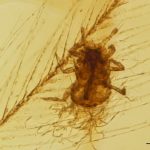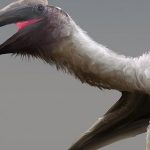Dinosaurs had feathers ruffled by parasites, study finds0
- Ancient Archeology, From Around the Web
- December 10, 2019
Ancient pieces of amber found to contain dinosaur feathers riddled with louse-like insects

Ancient pieces of amber found to contain dinosaur feathers riddled with louse-like insects

Apart from the asteroid that wiped out the dinosaurs 65 million years ago, there aren’t many connections between space and dinosaurs outside of the imagination. But that all changed when NASA research scientist Jessie Christiansen brought the two together in an animation on social media this month.

Palaeontologists have identified one of the largest flying creatures ever to live on planet Earth. This gargantuan creature, which soared through the Cretaceous skies over 76 million years ago, has been named Cryodrakon boreas, which means ‘frozen dragon of the north.’

When a colossal space rock came crashing down 66 million years ago onto what is now the Yucatan Penninsula in Mexico, it triggered widespread changes on Earth and abruptly ended the reign of the dinosaurs. Now, researchers are focusing on learning the extent of the asteroid’s destructive might and the immediate aftermath at ground zero, a location now known as the Chicxulub crater.

In an instant, the Chicxulub impact forever changed life on Earth—blasting out a huge crater, vaporizing and flinging up tons of rock, and devastating plant and animal life.

The duck-billed, crested lambeosaurine shows that a diverse array of dinos lived in the warmer but still harsh Arctic 70 million years ago

Research that had been kept secret for years that captured a fossilized snapshot of the day nearly 66 million years ago when an asteroid hit Earth, wiping out nearly all life on the planet, including the dinosaurs, has finally been released, shocking the scientific community.

Two studies agree that ancient eruptions likely played a supporting role in the mass extinction. But the devil is still in the details.

A new species of oviraptorosaur has been unearthed in the Gobi Desert of Mongolia.

When the dinosaur-killing asteroid collided with Earth more than 65 million years ago, it did not go gently into that good night. Rather, it blasted a nearly mile-high tsunami through the Gulf of Mexico that caused chaos throughout the world’s oceans, new research finds.